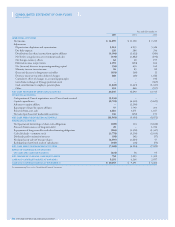Chevron 2005 Annual Report Download - page 61
Download and view the complete annual report
Please find page 61 of the 2005 Chevron annual report below. You can navigate through the pages in the report by either clicking on the pages listed below, or by using the keyword search tool below to find specific information within the annual report.
CHEVRON CORPORATION 2005 ANNUAL REPORT 59
any unrealized gains or losses included in “Other compre-
hensive income.”
Inventories Crude oil, petroleum products and chemicals are
generally stated at cost, using a Last-In, First-Out (LIFO)
method. In the aggregate, these costs are below market.
“Materials, supplies and other” inventories generally are
stated at average cost.
Properties, Plant and Equipment The successful efforts
method is used for crude oil and natural gas exploration and
production activities. All costs for development wells, related
plant and equipment, proved mineral interests in crude oil
and natural gas properties, and related asset retirement obli-
gation (ARO) assets are capitalized. Costs of exploratory
wells are capitalized pending determination of whether the
wells found proved reserves. Costs of wells that are assigned
proved reserves remain capitalized. Costs are also capitalized
for exploratory wells that have found crude oil and natural
gas reserves even if the reserves cannot be classifi ed as proved
when the drilling is completed, provided the exploratory well
has found a suffi cient quantity of reserves to justify its comple-
tion as a producing well and the company is making suffi cient
progress assessing the reserves and the economic and operating
viability of the project. All other exploratory wells and costs
are expensed. Refer to Note 20, beginning on page 73, for
additional discussion of accounting for suspended exploratory
well costs.
Long-lived assets to be held and used, including proved
crude oil and natural gas properties, are assessed for pos-
sible impairment by comparing their carrying values with
their asso ciated undiscounted future net before-tax cash
fl ows. Events that can trigger assessments for possible impair-
ments include write-downs of proved reserves based on fi eld
performance, signifi cant decreases in the market value of
an asset, signifi cant change in the extent or manner of use
of or a physical change in an asset, and a more-likely-than-
not expectation that a long-lived asset or asset group will be
sold or otherwise disposed of signifi cantly sooner than the
end of its previously estimated useful life. Impaired assets
are written down to their estimated fair values, generally
their discounted future net before-tax cash fl ows. For proved
crude oil and natural gas properties in the United States,
the company generally performs the impairment review on
an individual fi eld basis. Outside the United States, reviews
are performed on a country, concession or fi eld basis, as
appropriate. In the refi ning, marketing, transportation and
chemical areas, impairment reviews are generally done on
the basis of a refi nery, a plant, a marketing area or marketing
assets by country. Impairment amounts are recorded as incre-
mental “Depreciation, depletion and amortization” expense.
Long-lived assets that are held for sale are evaluated for
possible impairment by comparing the carrying value of the
asset with its fair value less the cost to sell. If the net book
value exceeds the fair value less cost to sell, the asset is consid-
ered impaired and adjusted to the lower value.
Effective January 1, 2003, the company implemented
Financial Accounting Standards Board Statement No. 143,
“Accounting for Asset Retirement Obligations (FAS 143),” in
which the fair value of a liability for an asset retirement obli-
gation is recorded as an asset and a liability when there is a
legal obligation associated with the retirement of a long-lived
asset and the amount can be reasonably estimated. Refer also
to Note 24, beginning on page 83, relating to asset retire-
ment obligations, which includes additional information on
the company’s adoption of FAS 143.
Depreciation and depletion of all capitalized costs of
proved crude oil and natural gas producing properties, except
mineral interests, are expensed using the unit-of-production
method by individual fi eld as the proved developed reserves
are produced. Depletion expenses for capitalized costs of
proved mineral interests are recognized using the unit-of-
production method by individual fi eld as the related proved
reserves are produced. Periodic valuation provisions for
impairment of capitalized costs of unproved mineral interests
are expensed.
Depreciation and depletion expenses for coal assets
are determined using the unit-of-production method as the
proved reserves are produced. The capitalized costs of all
other plant and equipment are depreciated or amortized over
their estimated useful lives. In general, the declining-balance
method is used to depreciate plant and equipment in the
United States; the straight-line method generally is used to
depreciate international plant and equipment and to amortize
all capitalized leased assets.
Gains or losses are not recognized for normal retirements
of properties, plant and equipment subject to composite
group amortization or depreciation. Gains or losses from
abnormal retirements are recorded as expenses and from sales
as “Other income.”
Expenditures for maintenance, repairs and minor renew-
als to maintain facilities in operating condition are generally
expensed as incurred. Major replacements and renewals are
capitalized.
Goodwill Goodwill acquired in a business combination is not
subject to amortization. As required by Financial Accounting
Standards Board (FASB) Statement No. 142, “Goodwill and
Other Intangible Assets,” the company will test such goodwill
at the reporting unit level for impairment on an annual basis
and between annual tests if an event occurs or circumstances
change that would more likely than not reduce the fair value
of a reporting unit below its carrying amount. The goodwill
arising from the Unocal acquisition is described in more
detail in Note 2, beginning on page 60.
Environmental Expenditures Environmental expenditures that
relate to ongoing operations or to conditions caused by past
operations are expensed. Expenditures that create future ben-
efi ts or contribute to future revenue generation are capitalized.
NOTE 1. SUMMARY OF SIGNIFICANT
ACCOUNTING POLICIES – Continued
























